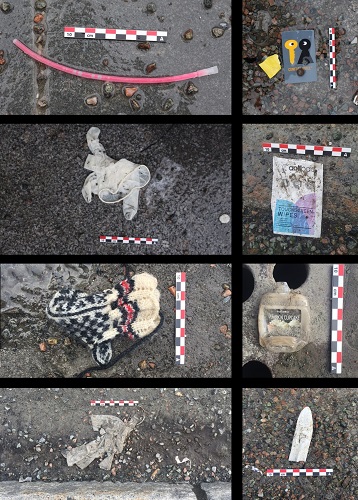Digital Methods for Archaeological Currents
Archaeology has long contributed new perspectives to past events, transcending written records through the interpretation of material culture. Applied to the present, archaeology has the potential to disrupt and nuance the memorialization of contemporary occurrences as they are inscribed.
Ongoing experiences of the COVID-19 pandemic vary widely, and will be remembered differently based upon the intersections of diverse geographical, social, and economic variables. Anthropologists were amongst the interdisciplinary scholars who worked to record, analyze, and reflect upon the crisis, as they also coped with it personally (see Angelo et al. 2021), and witnessed impacts more broadly on society and the environment (see for instance Schofield et al. 2021). Working with a team that bridged anthropological archaeology and social anthropology, our recently reported studies in Advances in Archaeological Practice and Journal of Social Archaeology began on March 12, 2020, in Tromsø, Norway, and spanned over a year of data collection (Magnani et al. 2021, Magnani et al. 2022).

A convergence of technological and theoretical advancements extends foundations for analyzing the material world. Our paper in Advances in Archaeological Practice establishes an accessible workflow to record current events. Matched with smartphone technology and free applications, spatial datasets recording material flows of the disaster are easy and inexpensive to collect, share, and synthesize. Yet, the study of ongoing events is challenging and requires an ethical, reflexive, and malleable approach; in our case, we continuously reevaluated our workflow to respect social distancing guidelines and health recommendations. With these considerations in mind, objects can be photographed and geotagged as they are encountered on the landscape and shared with collaborators with a swipe of the screen. Our workflow further integrated the collection of datasets derived from photogrammetry (see also Magnani et al. 2020), adding three-dimensional representations to two-dimensional maps. Drawing on these technological changes, one may contribute to these studies with minimal financial investment, expertise, and time.

If complex datasets for current events are easily and inexpensively captured, what do material approaches contribute to the interpretation and processing of crises like the pandemic (see also Magnani and Magnani 2021)? Documenting changing spaces and materials in Tromsø—ranging from discarded gloves and sanitization products to signs posted on doors—our work at first records an assemblage of variable coping mechanisms deployed in the absence of explicit government directives. With time, local innovations decreased in visibility and were ultimately overwhelmed by signs and strategies deployed by large corporations and state bodies. If more numerous and durable material culture will structure how the events are recalled in the future, memories of COVID-19 in Norway may become aligned with centralized corporate and state representations and not the vernacular responses of individuals operating in the absence of clear government mandates.
Scholars have leveled an archaeological gaze at contemporary material culture for decades (e.g., Binford 1978, Buchli and Lucas 2001, Rathje 1977). What makes this moment different? A confluence of new technologies and a heightened drive for social relevance sets this era of scholarship apart. We encourage other archaeologists– regardless of their temporal or regional specializations– to consider how their own perspectives, rooted in the analysis of materiality and captured on their smartphones, may contribute archaeological understandings to the contemporary world.
Angelo, Dante, Kelly M. Britt, Margaret Lou Brown, and Stacey L. Camp. “Spaces: documenting COVID-19 material culture and landscapes.” Journal of Contemporary Archaeology (2021): 8, 154-184.
Binford, Lewis Roberts. “Dimensional analysis of behavior and site structure: learning from an Eskimo hunting stand.” American Antiquity (1978): 43(3), 330–361.
Buchli, Victor, and Gavin Lucas. Archaeologies of the Contemporary Past. (2001). London and New York: Routledge.
Magnani, Matthew, Matthew Douglass, Whittaker Schroder, Jonathan Reeves, and David R. Braun. “The digital revolution to come: photogrammetry in archaeological practice.” American Antiquity (2020): 85(4), 737-760.
Magnani, Matthew, Natalia Magnani, Anatolijs Venovcevs, and Stein Farstadvoll. “A contemporary archaeology of pandemic.” Journal of Social Archaeology (2022).
Magnani, Matthew, Anatolijs Venovcevs, Stein Farstadvoll, and Natalia Magnani. “How to record current events like an archaeologist.” Advances in Archaeological Practice (2021): 1-8.
Magnani, Natalia, and Matthew Magnani. “Material methods for a rapid-response anthropology.” Social Anthropology (2020): 28 (2), 312-314.
Rathje, William Laurens. “In praise of archaeology: le projet du garbage.” Society for Historical Archaeology Special Publication Series (1977): 2, 36–42.
Schofield, John, Estelle Praet, Kathy A. Townsend, and Joanna Vince. “‘COVID waste’and social media as method: an archaeology of personal protective equipment and its contribution to policy.” Antiquity (2021): 95 (380), 435-449.






thanks for your valuable information. we will refer it to others. for more information you can go through our page.